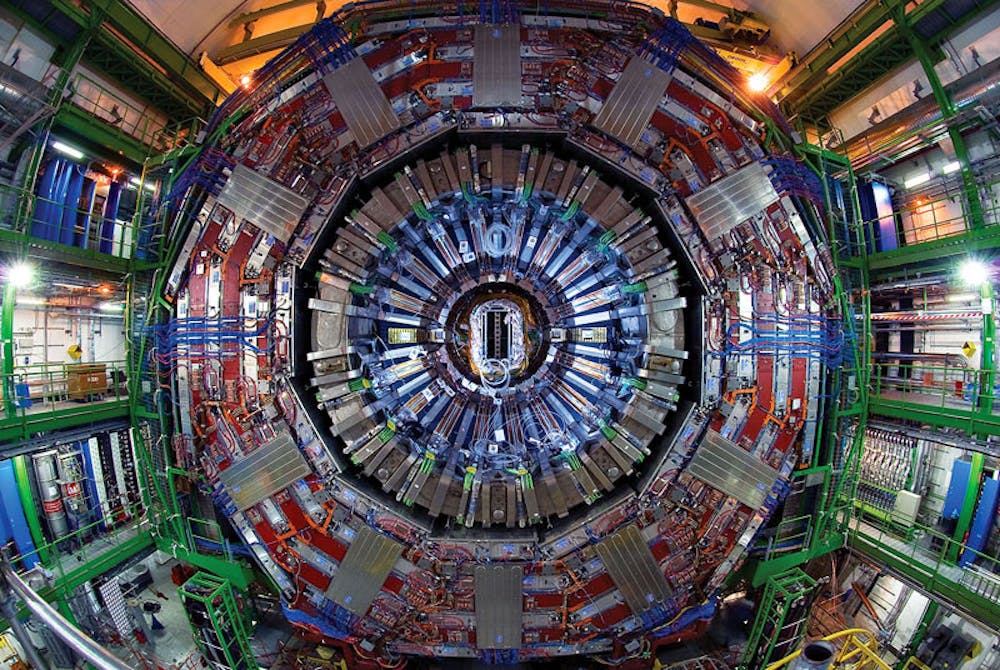Every October, the world awaits the announcement of the year’s Nobel Prize winners, but when it comes to awarding the Nobel in scientific fields, there is often not enough room in the spotlight to recognize the many scientists whose efforts contribute to breakthrough discoveries.
The scientific community was especially aware of the narrow spotlight this year — while it was widely expected that the physics prize would be awarded to the individuals who made last summer’s discovery of the Higgs boson possible, there was less consensus as to which physicists would receive the honor. Many news sources named University Professor of Physics Gerald Guralnik as a possible contender for the prize, but he ultimately was not recognized.
Peter Higgs, professor emeritus of theoretical physics at the University of Edinburgh, and Francois Englert, professor emeritus of physics at the Universite libre de Bruxelles, were announced as this year’s winners of the Nobel Prize in Physics Tuesday for their pioneering theory of the Higgs boson — a particle that helps explain the existence of mass. Their theoretical paper was originally published nearly 50 years ago, but on July 4, 2012, two independent teams of physicists working for CERN at the Large Hadron Collider near Geneva, Switzerland confirmed the existence of the particle.
But Higgs and Englert were not the only physicists who contributed to the discovery. In 1964, three papers related to the boson were published in the prestigious physics journal Physical Review Letters. Englert, along with Robert Brout, who died in 2011, collaborated on the first paper. Higgs wrote the second.
The third paper was a collaboration between Carl Hagen, a professor of physics at the University of Rochester, Tom Kibble, professor emeritus of physics at the Imperial College London, and Guralnik. Guralnik called this third paper the “most complete work,” citing its explanation of how the proposed boson did not conflict with fundamental principles of physics.
In a twist, Guralnik’s paper may have been written first, but he and his team were not sure if their paper was correct. They waited to confirm their findings and sent their paper to the journal after the other two papers were already published, but Guralnik’s team reached their conclusions independently.
Guralnik said he guessed that Higgs and Englert would win the Nobel Prize based on the Royal Swedish Academy of Sciences’governing rules. The body recognizes a maximum of three scientists for one prize and gives preference to those with the earliest publication date, Guralnik said.
‘No physicist is an island’
The Nobel Prize is “a limited prize,” said James Valles, professor of physics and chair of the physics department. “There are times when people form a fruit and pick it, and that’s what the Nobel Prize is able to recognize,” he said.
“In some sense the structure of the Nobel Prize doesn’t fit particle physics or any other science very well,” said Professor of Physics Ulrich Heintz, who worked with the team of experimental physicists at CERN. “The way we do science has evolved. It is impossible to whittle it down to three people.”
In the case of the Higgs boson, thousands of physicists contributed to the discovery of a particle that is likely the one described in the three theoretical papers from 1964. The awarding of the prize solely to theoretical physicists does not fully recognize the tremendous contributions of the people who worked more experimentally, Heintz said.
In addition to Heintz, Professors of Physics Meenakshi Narain, David Cutts and Greg Landsberg also contributed to the experimental side of the discovery.
“There are more than one, two or three in developing an idea. As science gets more complex, there are more people solving a problem,” Guralnik said. “Am I a little hurt that I’m not on it? Sure.”
Guralnik pointed to an op-ed in the New York Times by Sean Carroll, a theoretical physicist at the California Institute of Technology, entitled “No Physicist Is an Island.” In the piece, Carroll argues that the science Nobel Prizes should each be able to be awarded to more than three individuals.
“What the New York Times article did so well was accentuate the collaborative nature of science,” Valles said.
Heintz also said other prizes, such as the J. J. Sakurai Prize for Theoretical Particle Physics, may be given to a greater number of individuals, avoiding the limitations of the Nobel. For example, the 2010 Sakurai Prize was awarded to all of the authors of the three theoretical papers, including Guralnik, for their work on the Higgs mechanism.
‘A milestone for all of us’
Though the Nobel Prize could not recognize everyone who contributed to the Higgs discovery, Guralnik, Valles and Heintz all said the awarding of the prize to Higgs and Englert drew welcome attention to the field of theoretical particle physics.
Heintz said it would have been nice for the University’s physics department and community as a whole had Guralnik been awarded the prize. But still, he said, “it’s a milestone for all of us in particle physics.”
Despite not being publicly recognized, Guralnik said he was happy to find out his work in theoretical physics was correct.
“The public has seen abstract science can be exciting. … It renews my faith in humanity,” Guralnik said. “I’m glad they got the prize. It’s good for the work and good for physics.”

ADVERTISEMENT




